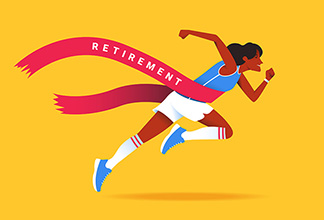Does FOMO Have You Jumping on the Latest Trend?
Written by Kanwal Rafiq
Published on April 8, 2017
minute read
Share:
Growing up I was always told: eat everything in moderation, exercise for 20 minutes a day, and you'll stay fit. Today when I head to the gym, I'll see the person beside me deadlifting 300 pounds as I struggle with my 40. The voice inside my head says, “push yourself harder." So I plug my earphones in, blast Kanye West's "Stronger," and push myself harder. On social media, my feeds are flooded with decorative acai bowls and perfectly cut abs alongside trending hashtags like #Teatox #Cleaneating and #Crossfit. When did things change so much? This sounds nothing like the "moderation" advice I got!
Strenuous workouts and new diet regimes seem to be the benchmark for a so-called healthy lifestyle. But how do you know what's right for you? Following the latest health fads can be like investing: both require you to consider some key points to ensure you're going to get where you want to go without just jumping on a bandwagon.
1. Watch Out for FOMO
As people tout their green smoothies and fancy yoga poses all over our social-media feeds, we can be hit with what's known as FOMO, or Fear of Missing Out. Take "teatoxing" for example, a booming trend in the world of celebrity endorsements. The basic idea: a tea-based detox that promises an increased metabolism and flat tummy. But before boiling the kettle, you may want to ask yourself just how much those celebrity endorsements have influenced you. It's a good question to keep in mind when it comes to investments, too. A security may be getting a lot of attention in the media, but does that make it right for you? You may decide you want a fuller picture before making your decision.
2. Check Your Risk Comfort Level
A risk that's become associated with the extreme workout fad is rhabdomyolysis, or rhabdo for short. It's caused when muscle fibres break down and enter the bloodstream, resulting in kidney damage. Of course this isn't always the case, and heavy weight lifting and intense conditioning fitness programs have gained in popularity over the last few years. The general consensus in both the investing and fitness worlds is that products or routines with higher risk levels can have the potential for higher returns. Extreme workouts are often designed to get you results faster, but knowing how much risk you're willing to take on will help determine the right path for you.
3. Do Some Heavy Lifting with Your Research
Research can be especially important when trying to understand just what's driving certain trends. When it comes to health and fitness, knowing the specific ingredients of various "teatox" blends will help ensure you're making an informed decision about what you're putting in your body. Many diet products recommend consulting a doctor before beginning. Research and analysis in investing can also help you make smart portfolio decisions.
4. Know Where You're Headed
Have a clear picture of what you want to accomplish. If you're looking to lose weight quickly, then you may lean toward a fad trend that promises quick results. If you're in it for the long haul, that's where moderation can make a comeback — with a plan to limit junk food in general and find a favourite exercise to get you to your goal. Similarly, setting clear goals about what you're saving for and how long you've got to get there can help you figure out which investments fit well into your portfolio.
RBC Direct Investing Inc. and Royal Bank of Canada are separate corporate entities which are affiliated. RBC Direct Investing Inc. is a wholly owned subsidiary of Royal Bank of Canada and is a Member of the Canadian Investment Regulatory Organization and the Canadian Investor Protection Fund. Royal Bank of Canada and certain of its issuers are related to RBC Direct Investing Inc. RBC Direct Investing Inc. does not provide investment advice or recommendations regarding the purchase or sale of any securities. Investors are responsible for their own investment decisions. RBC Direct Investing is a business name used by RBC Direct Investing Inc. ® / ™ Trademark(s) of Royal Bank of Canada. RBC and Royal Bank are registered trademarks of Royal Bank of Canada. Used under licence.
© Royal Bank of Canada 2025.
Any information, opinions or views provided in this document, including hyperlinks to the RBC Direct Investing Inc. website or the websites of its affiliates or third parties, are for your general information only, and are not intended to provide legal, investment, financial, accounting, tax or other professional advice. While information presented is believed to be factual and current, its accuracy is not guaranteed and it should not be regarded as a complete analysis of the subjects discussed. All expressions of opinion reflect the judgment of the author(s) as of the date of publication and are subject to change. No endorsement of any third parties or their advice, opinions, information, products or services is expressly given or implied by RBC Direct Investing Inc. or its affiliates. You should consult with your advisor before taking any action based upon the information contained in this document.
Furthermore, the products, services and securities referred to in this publication are only available in Canada and other jurisdictions where they may be legally offered for sale. Information available on the RBC Direct Investing website is intended for access by residents of Canada only, and should not be accessed from any jurisdiction outside Canada.
Explore More

Should I Invest or Pay Down My Mortgage?
Consider these four questions
minute read

As Many Head Back to the Office, Where Could Investors See Changes?
How returning to in-person work could affect a range of investments
minute read

Considering the FIRE Lifestyle? Here’s What Your Investments Might Look Like
We asked three people how they created financial independence and retired early
minute read
Inspired Investor brings you personal stories, timely information and expert insights to empower your investment decisions. Visit About Us to find out more.







